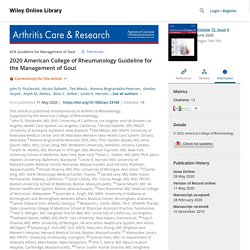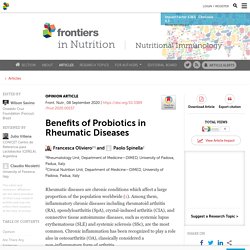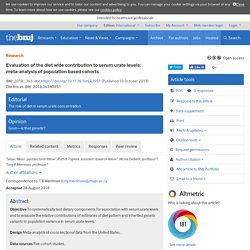

Full article: The gut microbiota as a target to control hyperuricemia pathogenesis: Potential mechanisms and therapeutic strategies. 2020 American College of Rheumatology Guideline for the Management of Gout - FitzGerald - 2020 - Arthritis Care & Research. Methods This guideline follows the ACR guideline development process ( using the Grading of Recommendations Assessment, Development and Evaluation (GRADE) methodology to rate the certainty of evidence and develop recommendations 15-17, with an emphasis on developing actionable guidelines.

ACR policy guided the management of conflicts of interest and disclosures ( A full description of the methods is presented in Supplementary Appendix 1 (available on the Arthritis Care & Research web site at The Core Team prespecified outcomes as critical or important for each PICO question for the systematic literature review. Outcomes varied across PICO topic (for details, see Supplementary Appendix 3, at Gout flare and serum urate (SU) concentration (and tophus for PICO question 1) were specified as critical outcomes for all PICO questions specific to ULT. Pain was identified as critical for PICO questions specific to gout flare.
Results/Recommendations Indications for pharmacologic ULT Allopurinol. Benefits of Probiotics in Rheumatic Diseases. Rheumatic diseases are chronic conditions which affect a large proportion of the population worldwide (1).

Among them, inflammatory chronic diseases including rheumatoid arthritis (RA), spondyloarthritis (SpA), crystal-induced arthritis (CIA), and connective tissue autoimmune diseases, such as systemic lupus erythematosus (SLE) and systemic sclerosis (SSc), are the most common. Chronic inflammation has been recognized to play a role also in osteoarthritis (OA), classically considered a non-inflammatory form of arthritis. Although different risk factors influence their onset and development, these heterogeneous conditions share common clinical outcome including joint pain, disability, and comorbidities (2). Over the last years increasing attention have been paid to the role of diet in the pathogenesis and progression of rheumatic diseases. The most commonly used are Lactobacilli (L.), Bifidobacteria (B.), and Streptococci (S.), either as single species or in mixed culture.
Table 1. 1. 2. Evaluation of the diet wide contribution to serum urate levels: meta-analysis of population based cohorts. Abstract Objective To systematically test dietary components for association with serum urate levels and to evaluate the relative contributions of estimates of diet pattern and inherited genetic variants to population variance in serum urate levels.

Design Meta-analysis of cross sectional data from the United States. Data sources Five cohort studies. Review methods 16 760 individuals of European ancestry (8414 men and 8346 women) from the US were included in analyses. Eligible individuals were aged over 18, without kidney disease or gout, and not taking urate lowering or diuretic drugs. Results Seven foods were associated with raised serum urate levels (beer, liquor, wine, potato, poultry, soft drinks, and meat (beef, pork, or lamb)) and eight foods were associated with reduced serum urate levels (eggs, peanuts, cold cereal, skim milk, cheese, brown bread, margarine, and non-citrus fruits) in the male, female, or full cohorts.
Introduction Methods Participants Dietary assessment Diet scores. ACP Guideline on Diagnosis of Acute Gout. ACP Guideline on Management of Acute and Recurrent Gout. Update on Importance of Diet in Gout - The American Journal of Medicine. Multinational evidence-based recommendations for the diagnosis and management of gout: integrating systematic literature review and expert opinion of a broad panel of rheumatologists in the 3e initiative. Abstract We aimed to develop evidence-based multinational recommendations for the diagnosis and management of gout.

Using a formal voting process, a panel of 78 international rheumatologists developed 10 key clinical questions pertinent to the diagnosis and management of gout. Each question was investigated with a systematic literature review. Medline, Embase, Cochrane CENTRAL and abstracts from 2010–2011 European League Against Rheumatism and American College of Rheumatology meetings were searched in each review. Relevant studies were independently reviewed by two individuals for data extraction and synthesis and risk of bias assessment. Introduction Gout is one of the most common inflammatory arthritis conditions, affecting up to 1–2% of men in Western countries1 and causing morbidity, disability and poorer quality of life.2 It is the consequence of deposition of monosodium urate (MSU) crystals in joints and other tissues, as a result of persistent hyperuricaemia. Methods Table 1 Results. גאוט שירי שרף דגן עתיד 2011.